| |
When visiting the botanical garden Flower Forest in Barbados, I was struck by the variety of plant life.
While researching some of the flowering plants at the botanical garden, it was drawn to my attention that while on the surface, many of the flowers appeared different, many of them in fact, belonged to same family and furthermore, have some unexpected relatives.
Strange relatives
We all have them.
What is surprising is that plants have them too.
Also like many of us, plants have very complex family trees.
Here is what I discovered:
Zingiberales
At Flower Forest, a variety of plants belong to the order of flowering plants known as Zingiberales, which are found in tropical regions worldwide.
On of the main defining characteristis of Zingiberales are "rhizomes", or "(creeping) rootstalks" - which are defined as nodes that produce horizontal growing roots and offshoots.
Research also indicates that rhizomes hold nutrients, such as starch and proteins.
Eight families of plants fall under the Zingiberales order. Many of the plants which I saw at Flower Forest, belonged to the Zingiberacea and Heliconiacea families.
Zingiberaceae (Ginger) Family
At Flower Forest some of the plants included in this family were the torch ginger, siam rose, jungle drum honeycomb, pink shell ginger, tulip torch ginger, Singapore gold and red ginger.
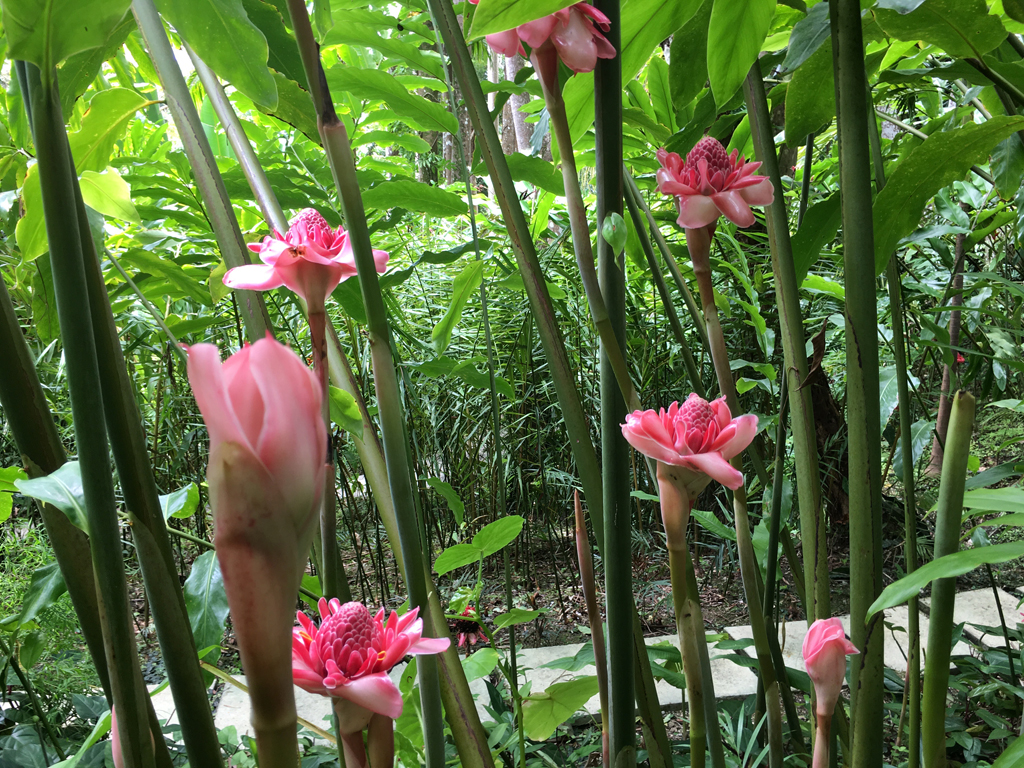
It is hard to imagine that these vibrant, tropical flowers, stem from the same family as ginger, tumeric and cardamom.
However, the similarities of these plants are more apparent beneath the surface. While researching the roots of some of these plants, their rhizomes bear a strong resemblance to ginger and tumeric as we know it.
In fact, when we eat ginger or tumeric, it is actually the "rhizome" we consume.
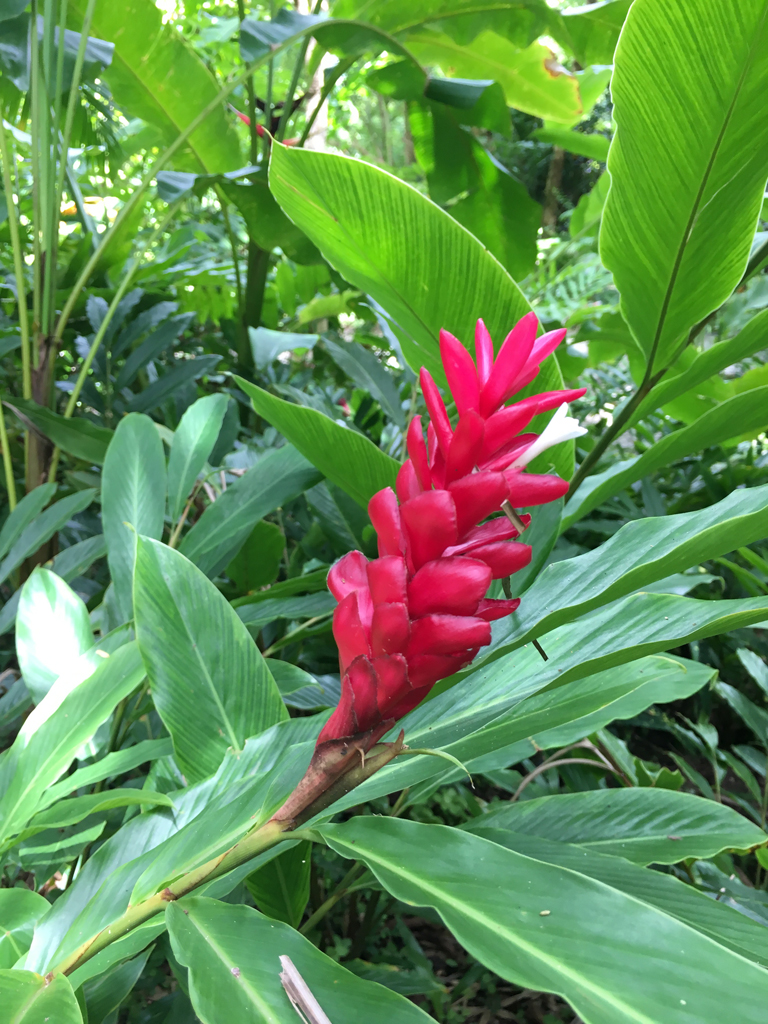
Although many of these plants are ornamental, research indicates that the various part of the plants of this family are also used for medicinal purposes as well as in dishes in the Far East and Pacific regions, such as Malayasia, Indonesia and Thailand.
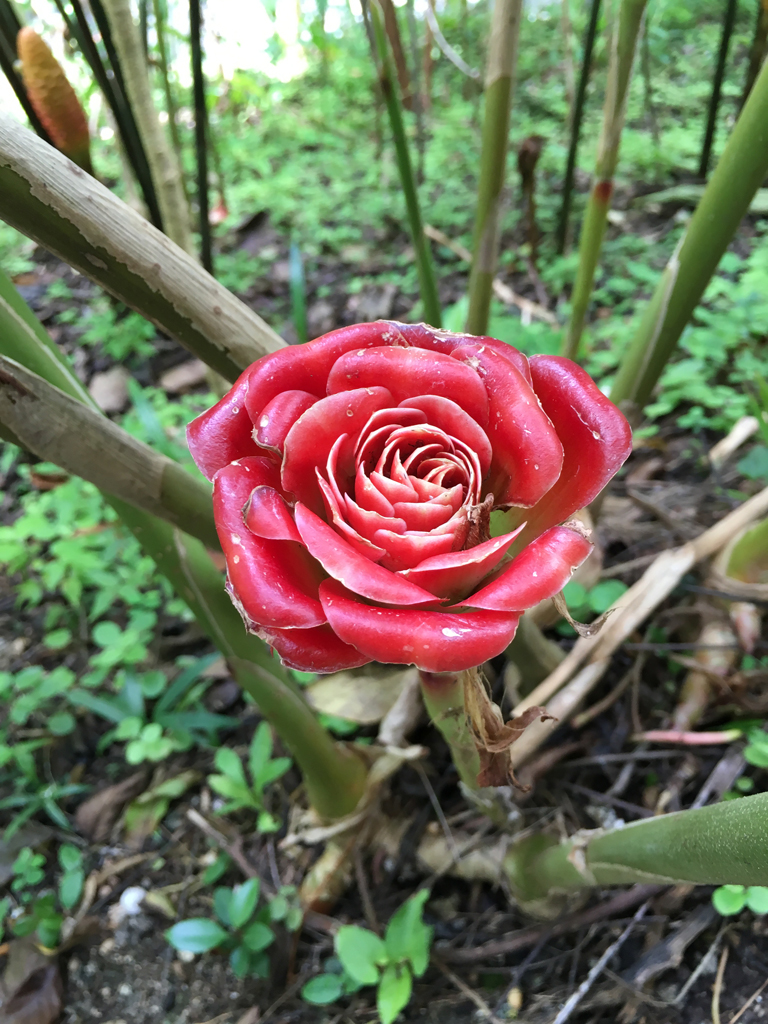
Crepe Ginger
Walking along the trails, ever so often I would see a stalk of leaves curling unusually, yet very gracefully.
|
|
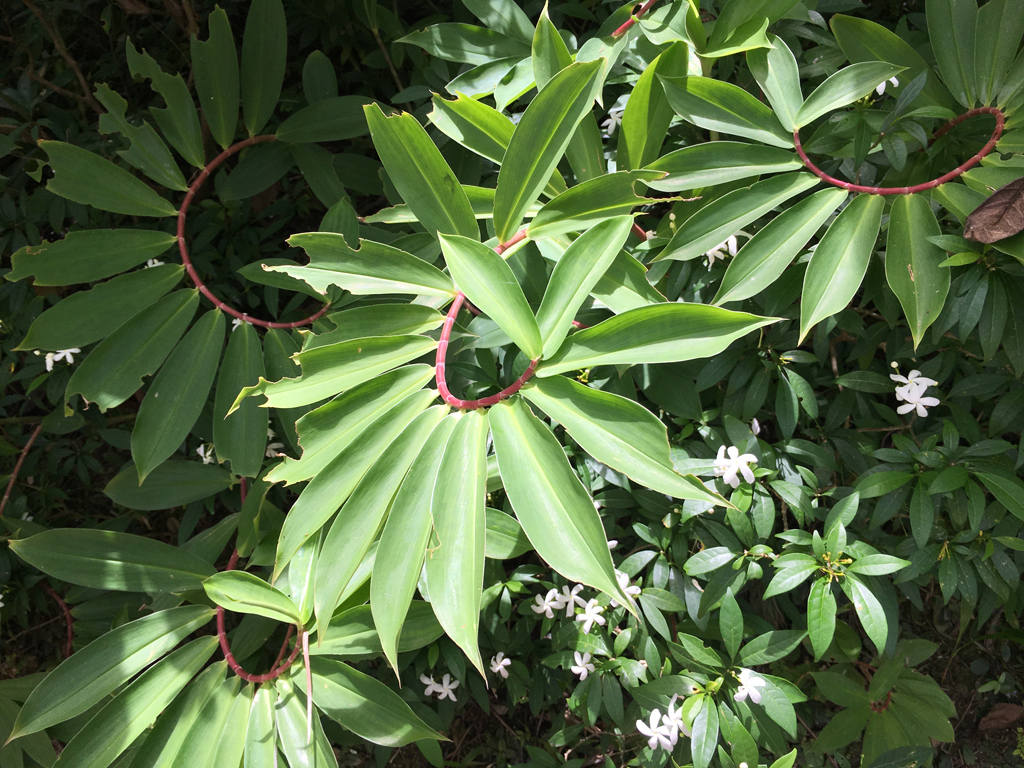
Known as crepe ginger or spiral ginger, this plant is also a part of the ginger family. In addition to the unusal spiral of leaves, unlike its flowering relatives mentioned above which are stiffer in appearance and more waxy in texture, the flower of the plant is very soft - resembling tissue or crepe paper.
Even though it is decorative plant, it is said to have medicinal properties and is also used for cosmetic purposes.
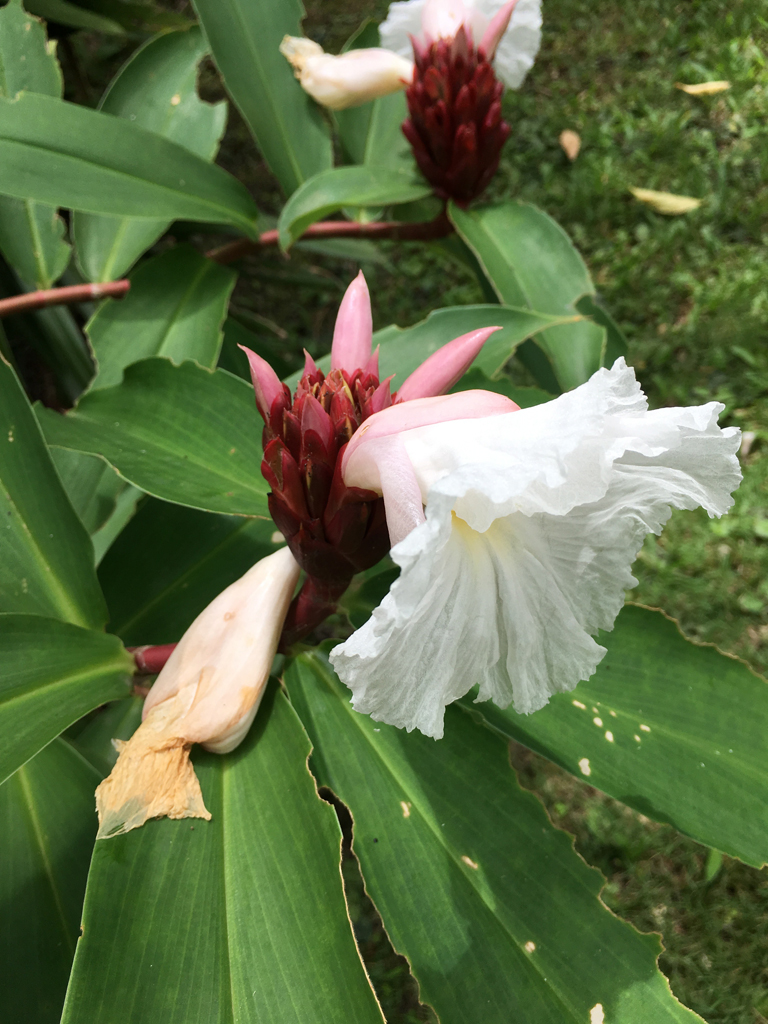
Heliconiacae Family (Heliconias)
Another family of plants seen around Flower Forest were heliconias. These included parrots beak, lobster claws and beefsteak heliconias.
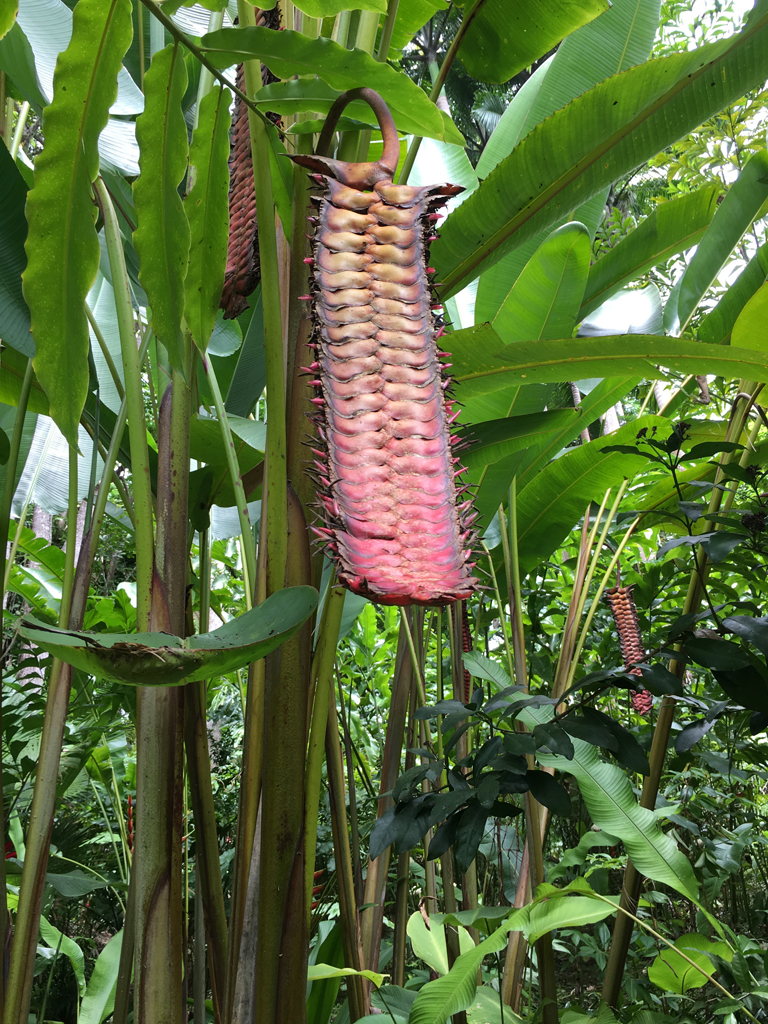
Heliconias are known for their brightly coloured bracts, which are often mistaken for the flowers themselves.
Generally, bracts have various purposes on plants and in the case of heliconias, one of them is to grab the attention of pollinators.
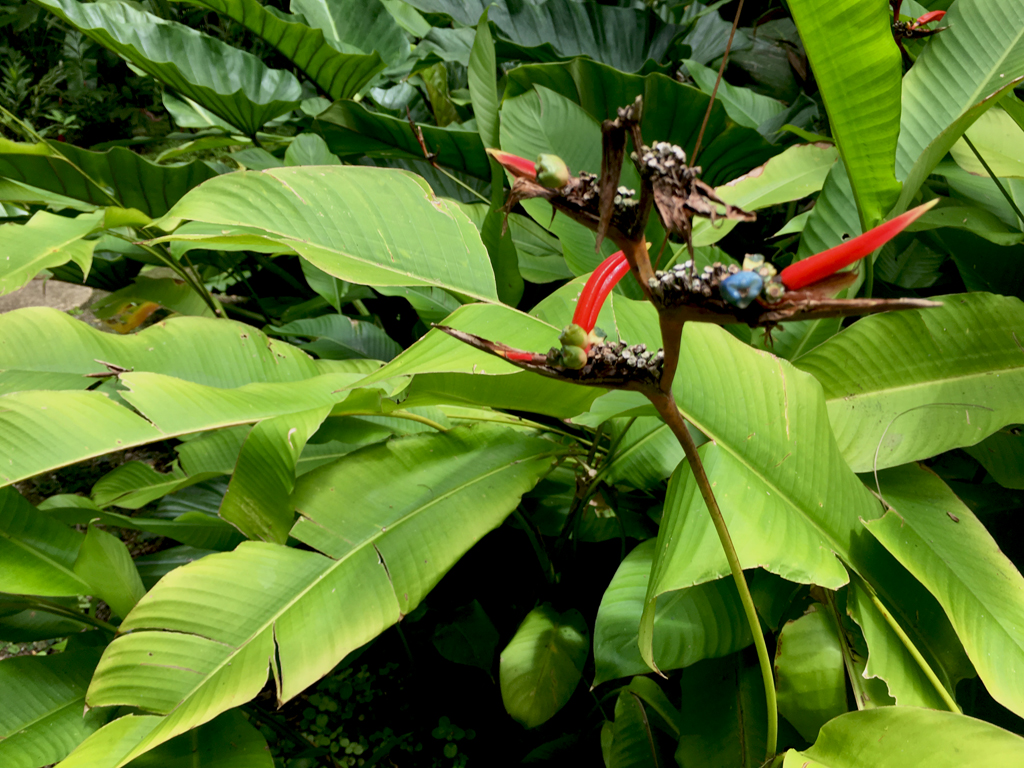
One of the only pollinators of heliconias is the hummingbird. These tiny birds are also attracted to the nectar contained in the flowers of these plants.
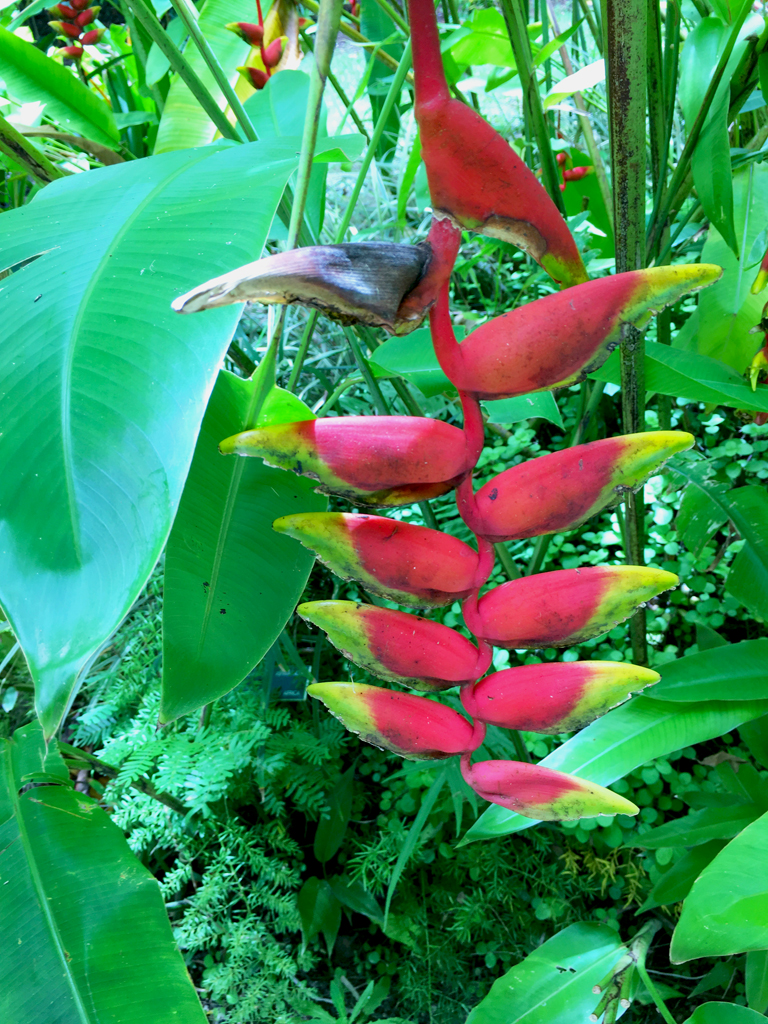
The leaves of heliconias bear a similar resemblance to those of banana plants (Musa family), to which heliconias are said to be related.
Besides being an ornamental plant, it is mentioned that heliconias provide a number of uses for various forms of wildlife, such as bats and insects, which seek shelter, water (sometimes stored in the bracts), food and even a breeding ground.
|
|
Musaceae (Banana) Family
Another family under the Zingiberales order that is worth mentioning is the Musaceae or banana family.
While banana trees are mainly known for their bright yellow produce rather than their attractiveness, at Flower Forest there was an unusual species of banana known as Flowering or Ornamental Banana. Research indicates that this species is native to Southeast Asia and while this plant can produce fruit, it is more used for decorative purposes, due its bright pink-purple bract.
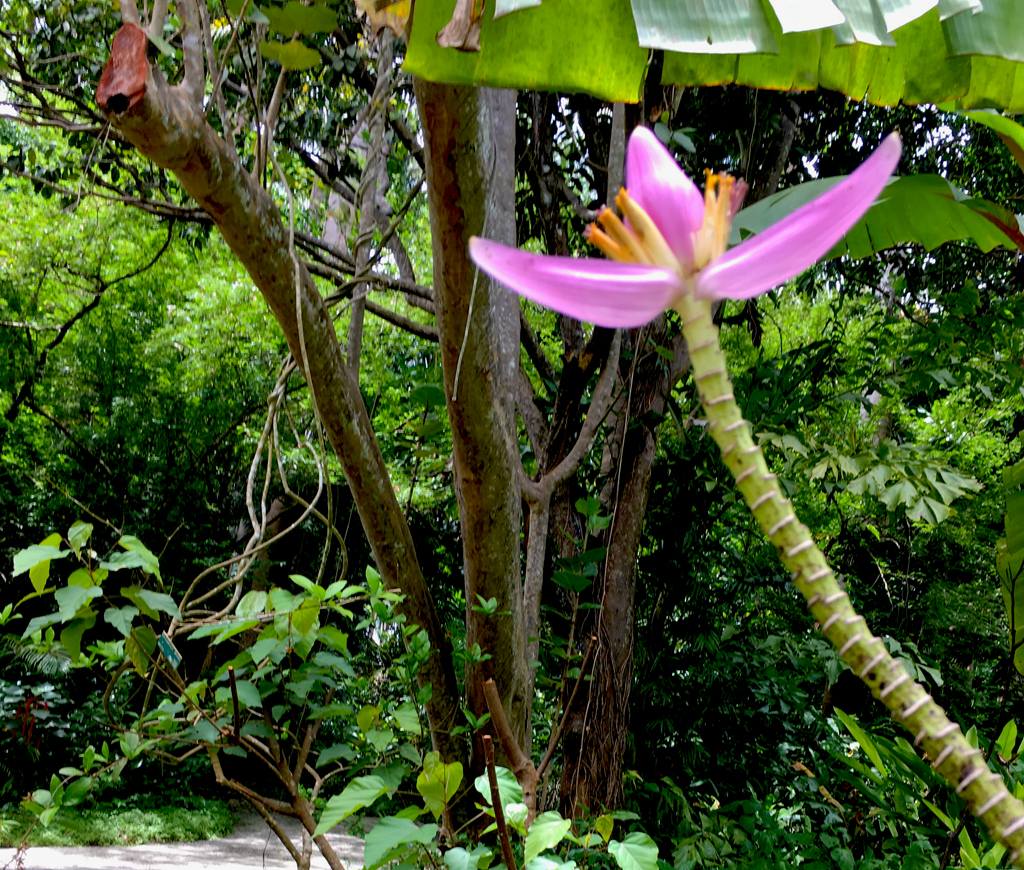
In Barbados, banana trees are commonly grown in gardens and on small lots. There are also other varieties available, such as plaintains, figs and what is known locally as "green banana" or "cooking banana" which is used in savoury dishes.
Another characteristic of the Zinigberales order, is the absence wood tissue. While this is not surprising on the smaller, decorative plants, it does bring into question the banana tree. The "trunk" of the tree, is actually known as a "pseudostem" - which is comprised of compacted leaf sheathes.Therefore the banana tree, as we know it, is not a tree at all.
Furthermore, It is hard to believe that like the ginger family, heliconias and other families in this order, entire "banana trees" also grow from rhizomes.
Marantaceae (Arrowroot or Prayer Plant Family)
Another unusual plant in the Zingiberales order and Marantaceae family is the Rattlesnake plant.
This plant is most commonly known for its unique infloresence - especially its arrangement of green/yellow bracts which bears an uncanny resemblance the tail of a rattlesnake.
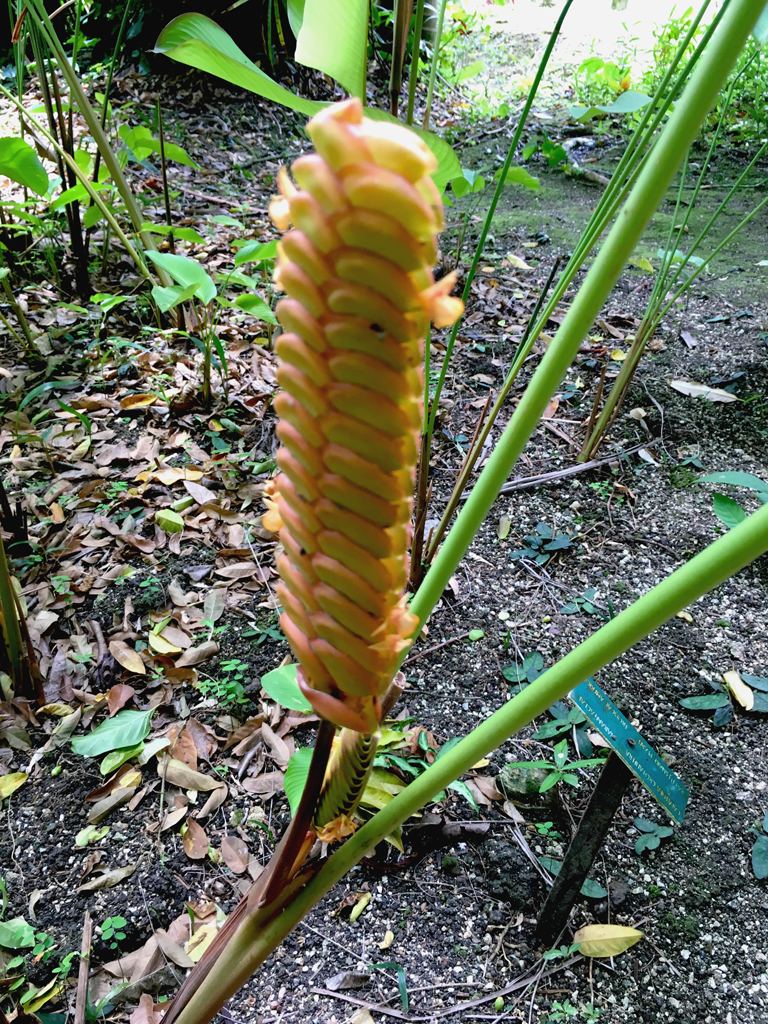
The Rattlesnake plant is native to Mexico and Central and South America and is related to arrowroot.
Beautiful Nature
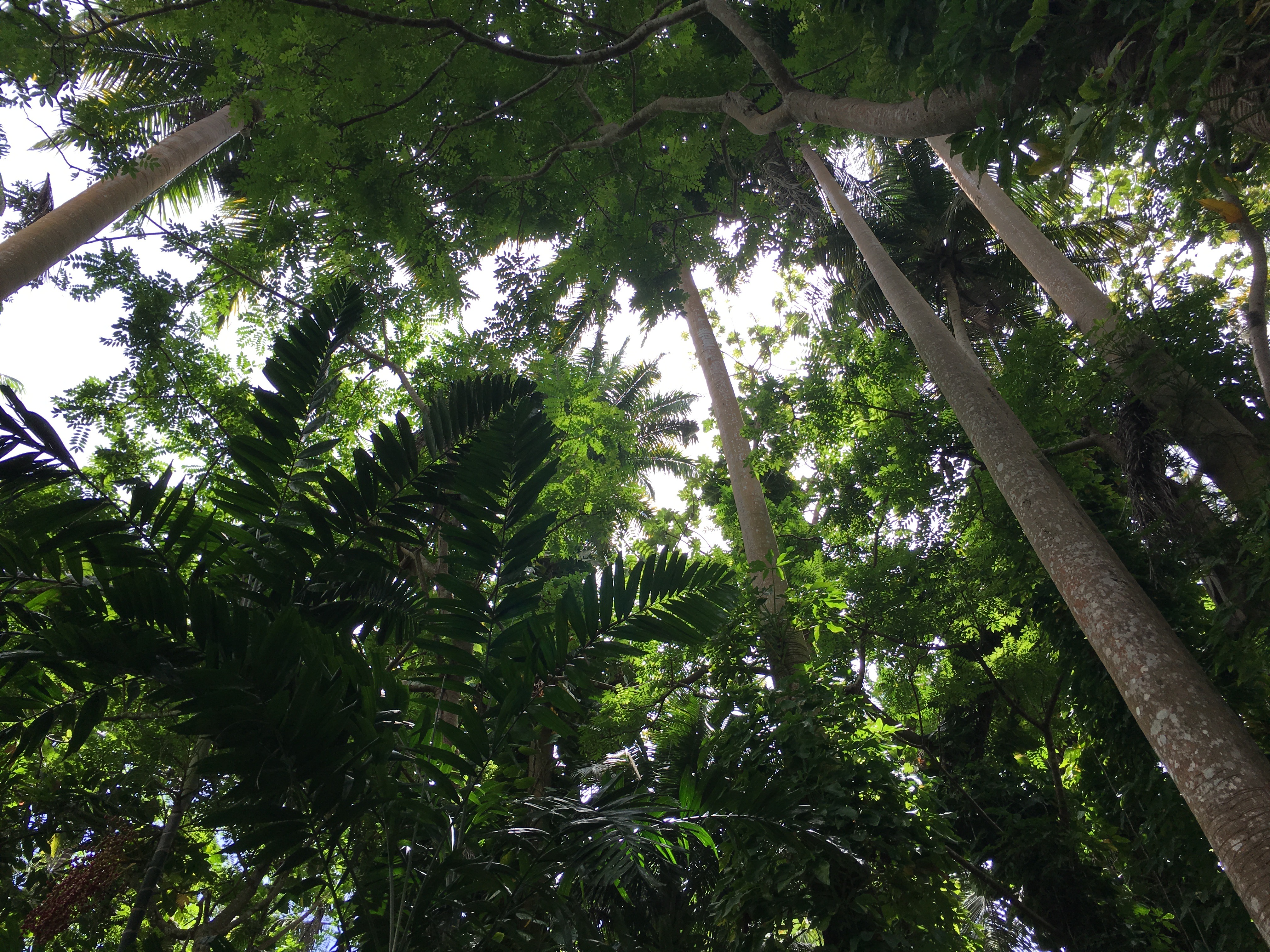
Whether we view them in parks and gardens, or bring them into our homes, flowers always seem to evoke a sense of warmth and happiness.
We admire them, they contribute immensely to our nourishment, environment and we use them for our everyday needs.
When visiting Flower Forest, I went with the intention of enjoying the outdoors and admiring beautiful plants. However, when researching the various plants, I uncovered a universe of information and grew to understand and appreciate their intricate growth structures and how many plants are very similar, yet very different from each other.
While we often admire flowers for the beauty they provide, it never ceases to amaze me, when I learn that they are just as complex as any other form of wildlife.
Related Articles:
A Splash of Colour: Part 1 |
|
|
| |
For many, when thinking of a tropical island like Barbados, images of the sun, sea and sand come to mind.
However, there are other beautiful attractions which the island has to offer. One such attraction is Flower Forest – a former sugar plantation, which over the decades has been transformed into a flourishing botanical garden located in the central parish of St. Thomas.
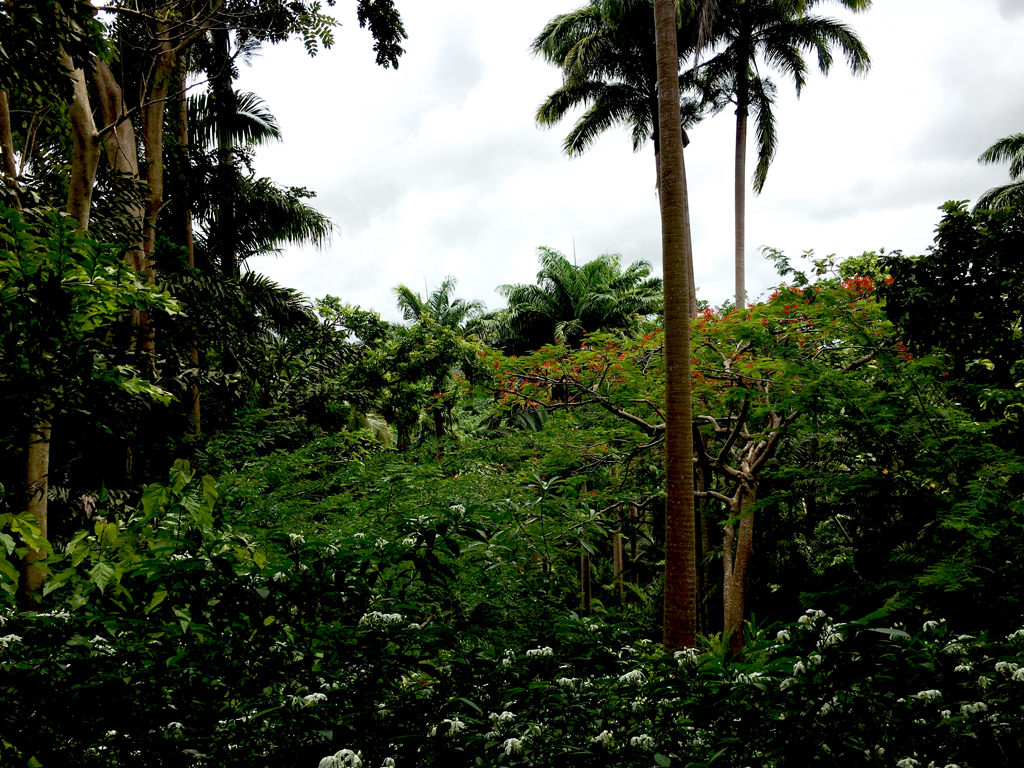
On a recent visit to Flower Forest, whilst making my way through the winding trails, I was struck by the colourful, beautiful and unusual flowers and plants.
The garden showcased a number of plants found both locally and internationally and making the visit more enriching was having the opportunity to view species which I was not familiar with and had never seen.
Furthermore, after researching some of the plant species, it was even more fascinating to learn about the various plants and some of their surprising relatives.
While the species of plant-life seemed endless, a few of my favourites are as follows:
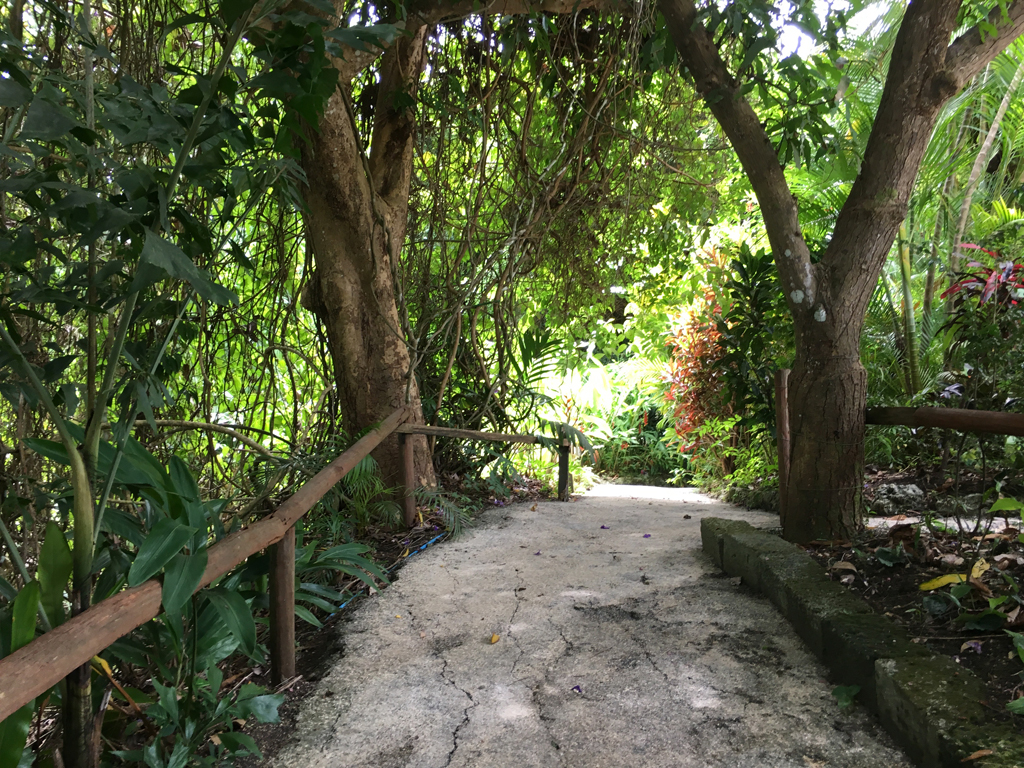
The Jade Vine
As we started the trail, one of the plants which was immediately drawn to our attention was the jade vine. Hanging in the trees above, the immediate, striking feature which makes this plant unique is its glowing blue and green hues.
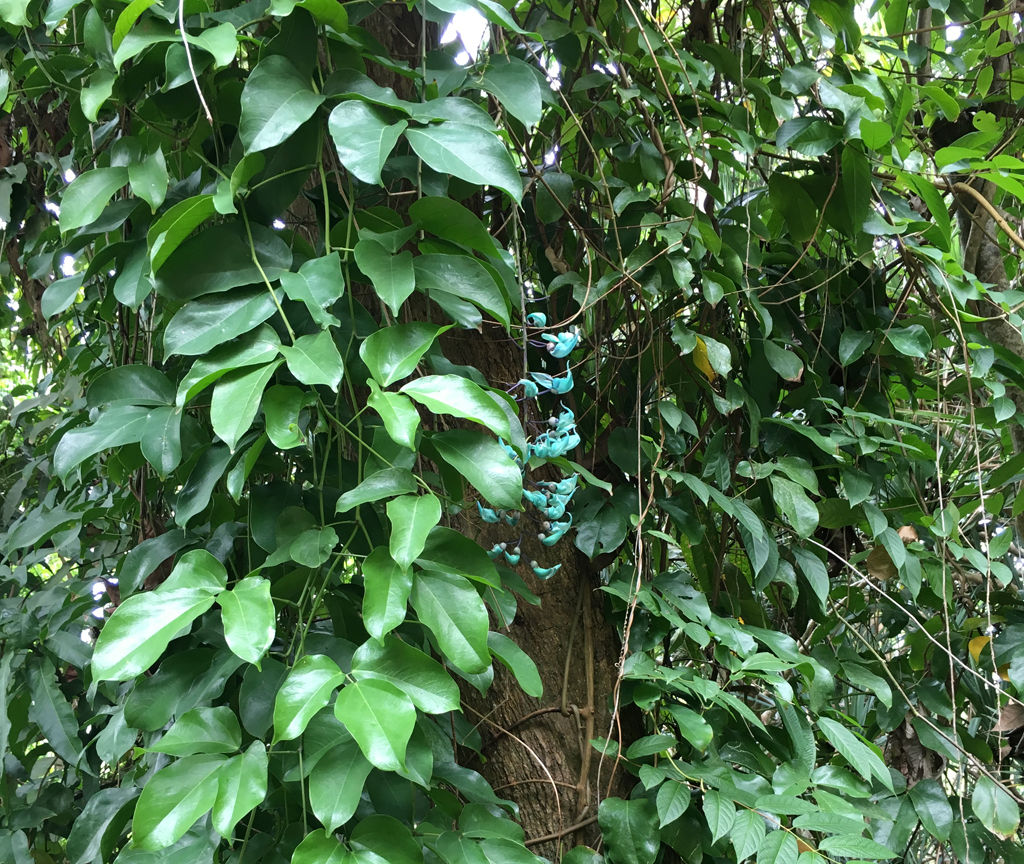
The jade vine originates from the Philippines and said to be endangered. I was surprised to discover that it is part of the bean family and a close relative of red kidney beans!
Bromeliads
I could immediately recognise the bromeliad plants as I had previously researched them after viewing them at Kew Gardens in London, England.
Scattered throughout the garden, their vibrant leaves seemed to be works of art.
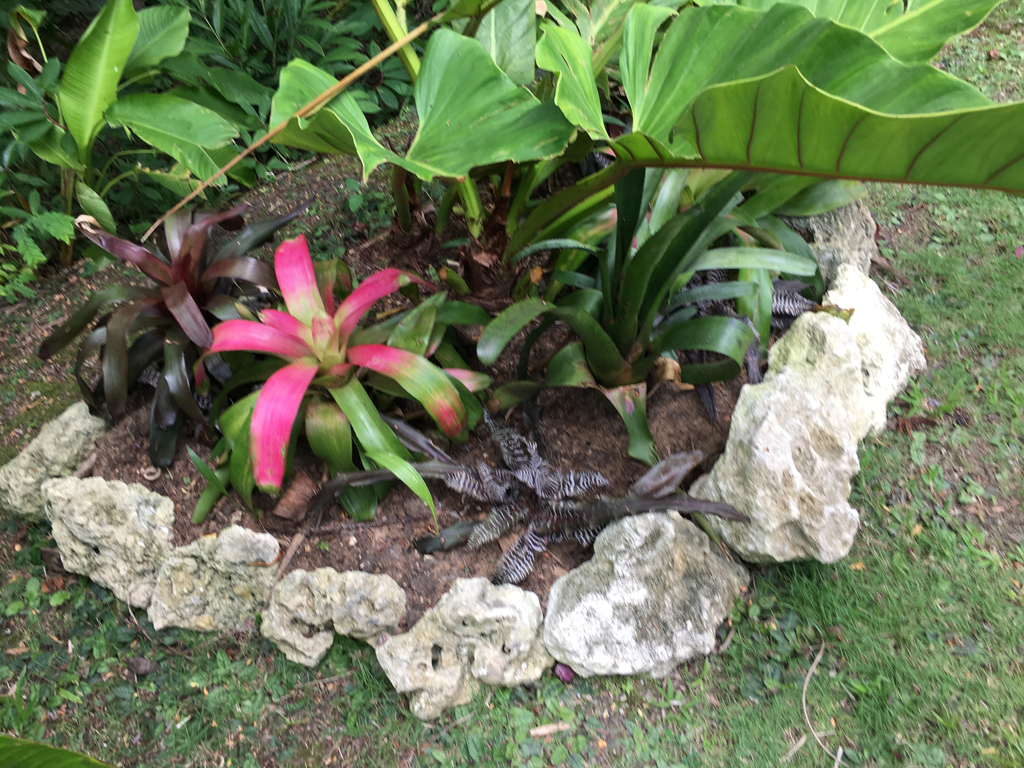
Recalling that I had read bromeliads have a symbiotic relationship with frogs, I peered into every bromeliad I could, hoping to find a frog spawn (or something equally as interesting) in the pools of water this plant collects.
I did not see any frogs, but my efforts did not go in vain, as one or two of the bromeliads were flowering.
While one of the plants had a thick, flowering stem protruding from its centre, another had lush green leaves and purple flowers
|
|
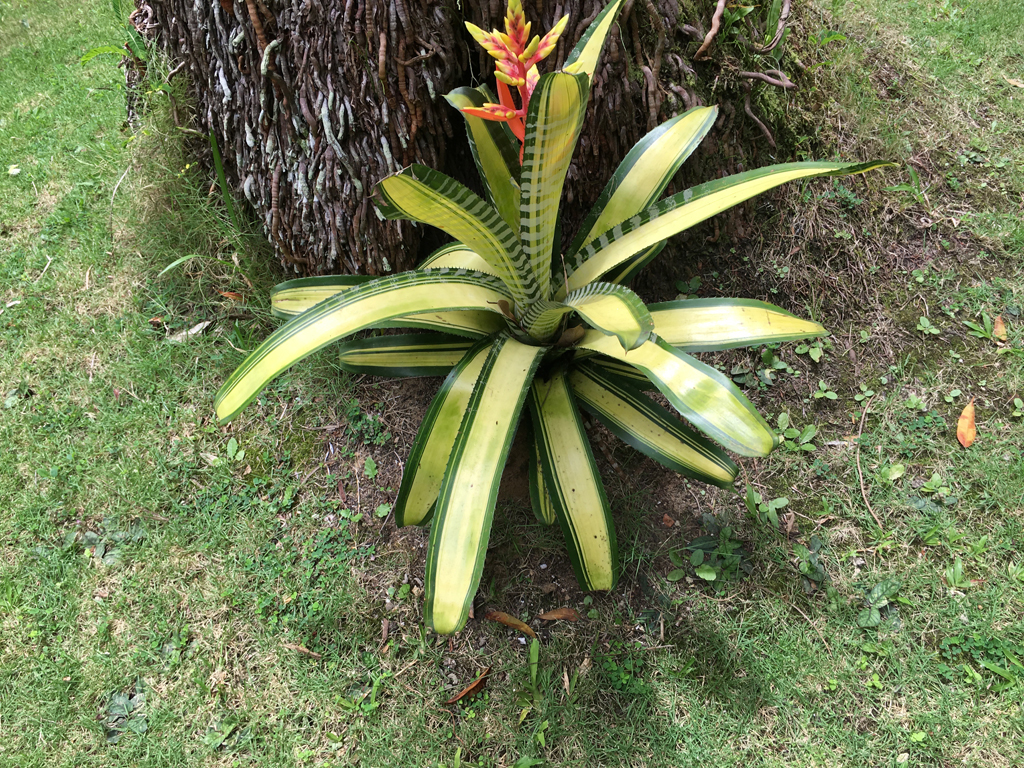
growing in its pool - resembling a scene of a pond, but in miniature. These delicate plants appeared very different from the thick tentacle-like bromeliad itself.
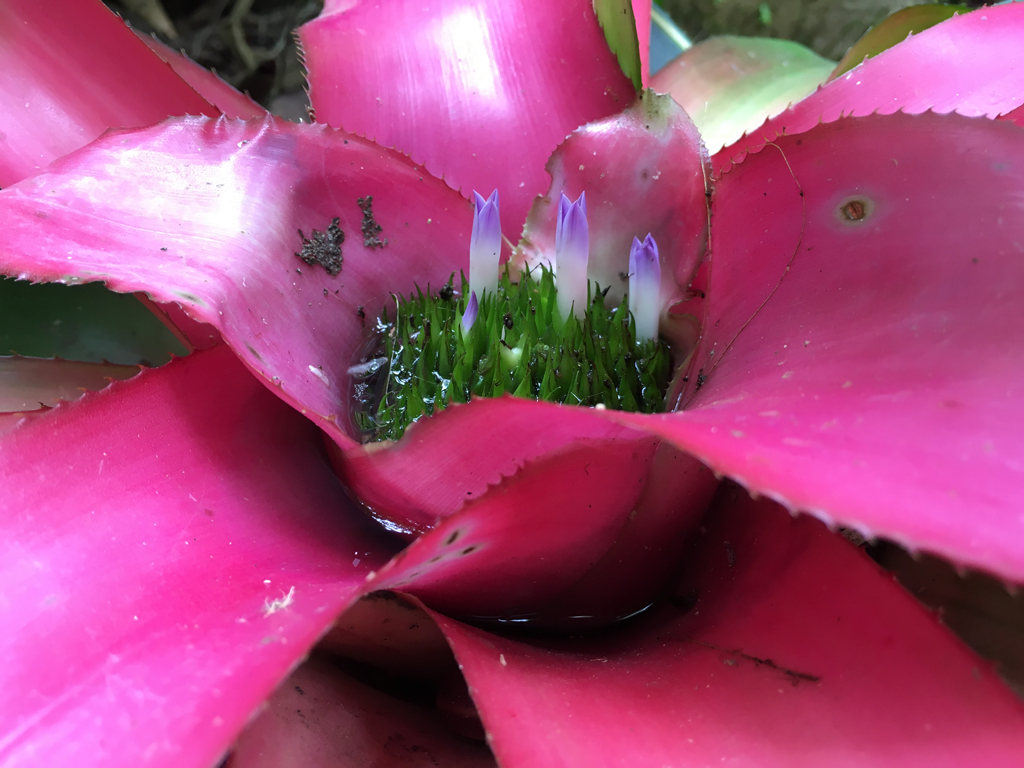
The Sandbox Tree
While walking past a grassy plain, the burly, sandbox tree was hard to miss. When taking a closer look, I realised that this was not the first time I had come across this tree as I suddenly recalled one being planted on the grounds of my former school.
This large tree has a thick trunk and is densely populated with small thorns, (somewhat resembling chocolate chips). I recalled pressing my hands against the hard thorns.
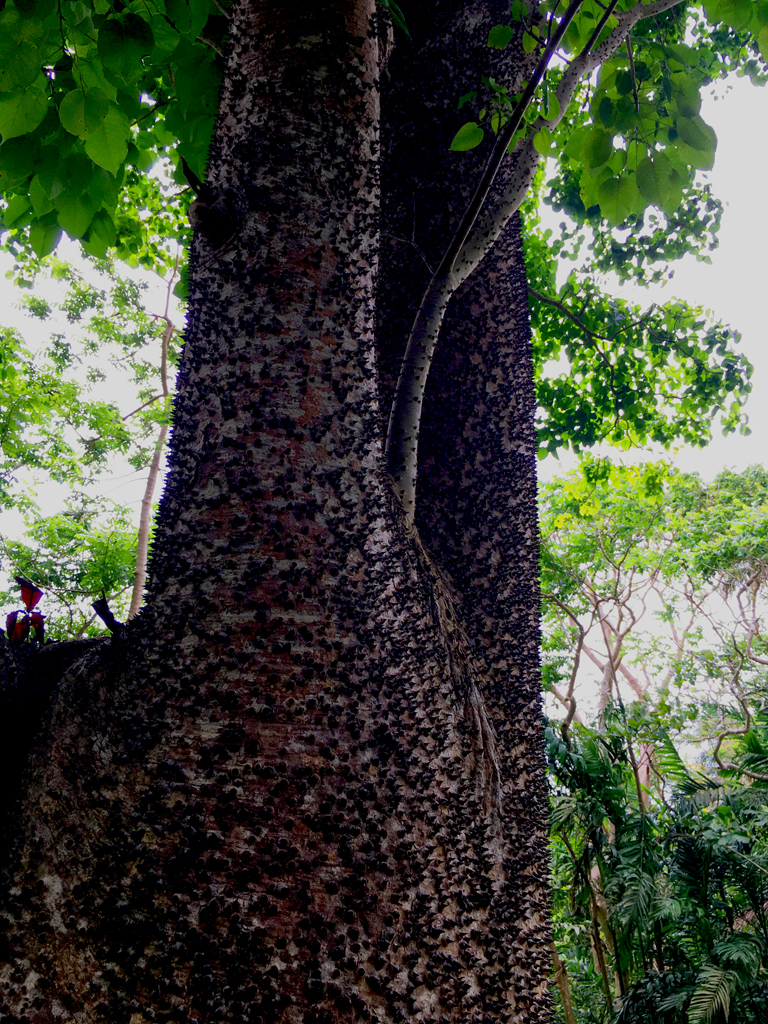
Research indicates that this tree is known by various names including "Hura creptians", “monkey-no-climb". Another name which this tree goes by is the “dynamite tree” as it is said that when the fruit of the tree ripen – they explode literally, with a bang.
Furthermore, it is said that the Caribs (an Amerindian tribe which inhabited Barbados before British colonisation) made their arrows using the poisonous sap of this tree.
Although, the sandbox tree appears to be one to stay away from, it is used to make furniture and the finished products are known to be made from "hura wood".
The Macaw Tree
I have always associated palm trees with a warm, inviting tropical setting – so what is striking about the Macaw Tree, are the angry, unwelcoming spikes which populate its trunk.
This tree is said to be native to the Caribbean islands of Martinique and Dominica, but is now found throughout the Caribbean, Mexico, and South America.
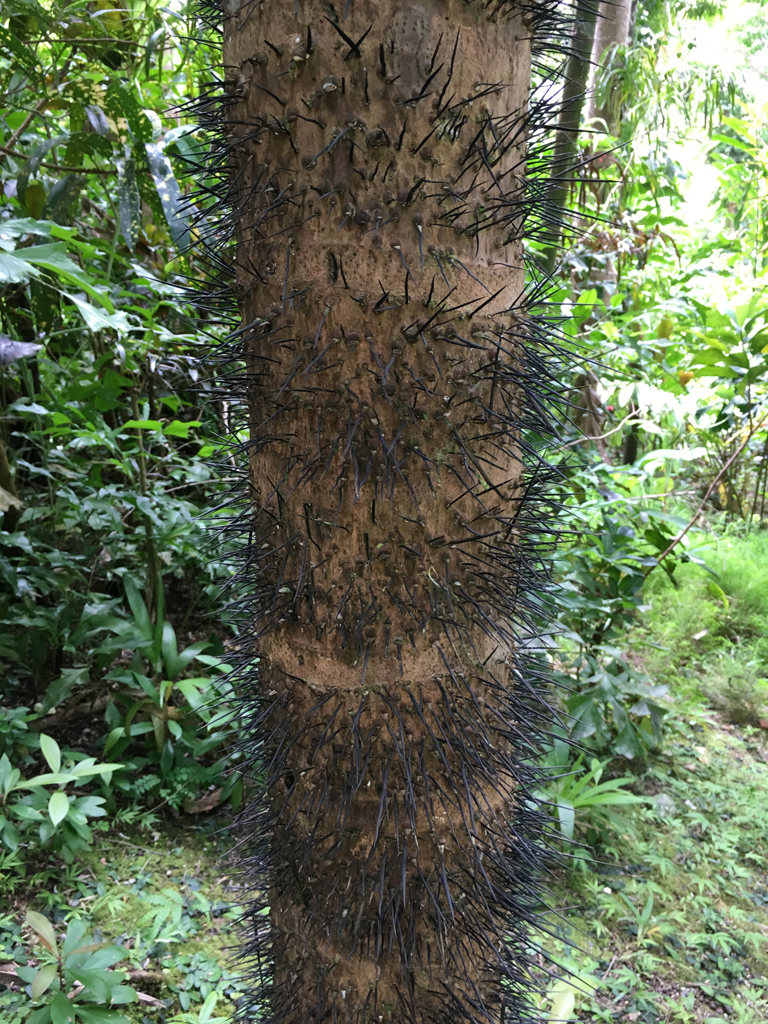
Its name has derived from the macaw bird which is said to feed on the fruit of the tree.
However, other names which this tree is known by are "gru gru palm" or "coyol palm" |
|
and a wine known as "coyol wine" is produced from this palm.
Red hot Cattails
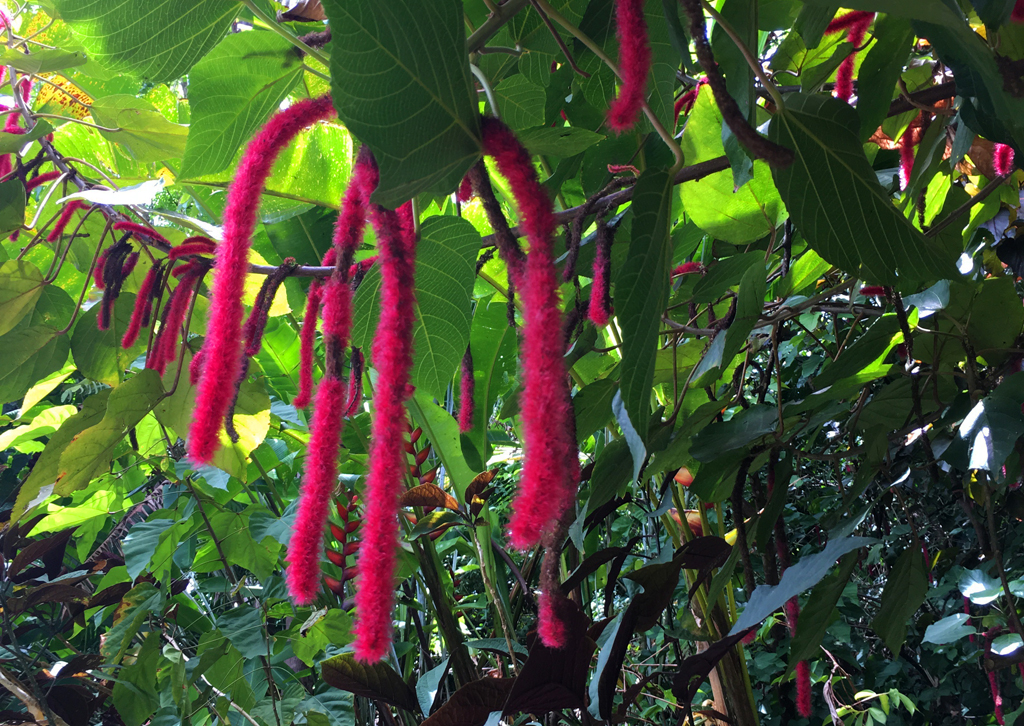
In Barbados, this unusual plant is often found in the gardens of resorts.
When passing by this plant, I have smelled a soft, sweet fragrance.
However, it is its tail-like shape, soft texture and bright red colouring that gives this plant an element of playfulness and it is almost impossible to resist touching it when passing by.
While the vibrant red hot cattail provides some amusement, it does have a sinister side, as research explains that it is poisonous.
Furthermore, the "flowers" of this plant are actually groups of the reproductive components of female plants known as "pistils".
Other names which this plant goes by are "fox tails" and chenille plants.
Anthurium Lily
In Barbados, anthurium lilies are decorative flowers often used in flower arrangements.
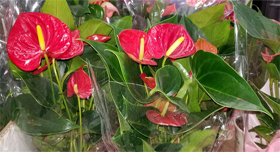
However, what is mistakenly thought to be the flower, is actually an arrangement of different structural components of the plant - the bract (spathe in the case of anthuriums) and the spadix.
Sometimes bright and colourful, bracts have various functions on plants and they (partially) envelope or encase flowers, leaves or stems - and they are often mistaken for these parts. On anthuriums, the spathe is the vibrant but stiff, waxy petal-like structure.
The textured, protruding stalk is the spadix - a type of inflorescence (a support structure of some plants which have their individual flowers growing in bunches). Therefore, it is on the spadix that the actual flowers of this plant grow.
Like the red hot cattails, this vibrant plant is somewhat of a trojan horse, as although unique and beautiful, it is also poisonous.
Beautiful Nature
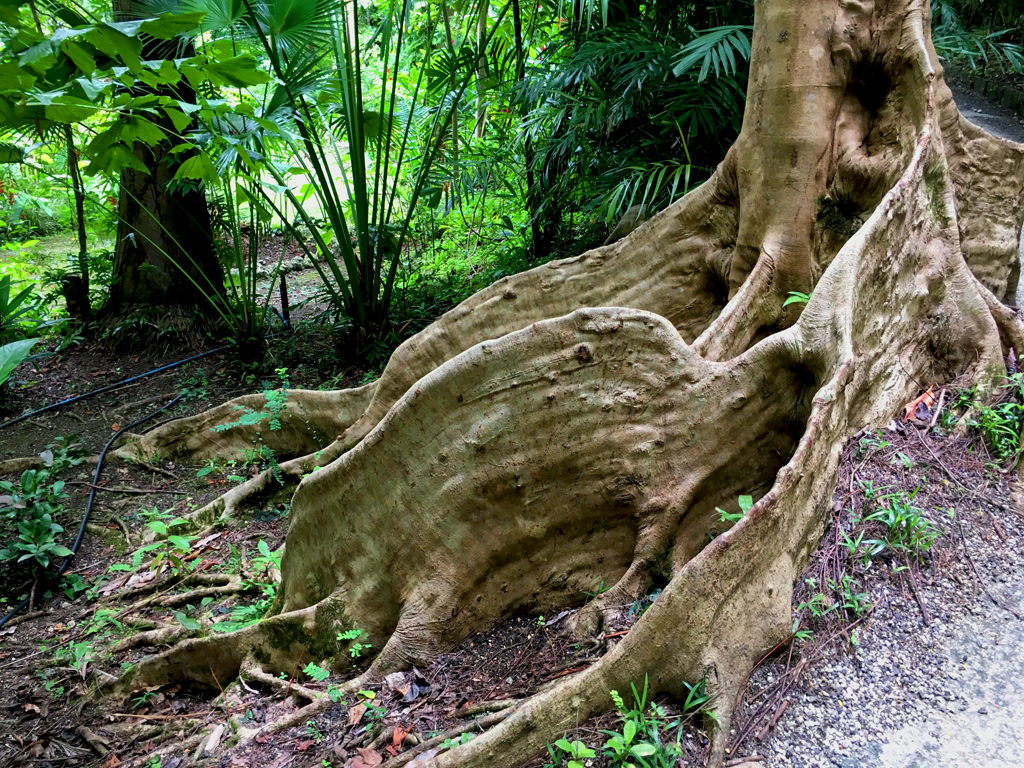
I immensely enjoyed viewing and learning more about the colourful plants I saw on my visit to Flower Forest.
Trips to various gardens or even plant nurseries can help us to further understand the complexities and value which plants bring to us and our environment. Admittedly, I often bypass many plants, not even aware of their existence and it is only when they are drawn to my attention, that I can fully appreciate them as more than "just part of the scenery".
It was, therefore, fascinating to uncover the complexities of the plants and a reminder of how much they provide for us, without asking for anything in return.
Related Articles:
Beyond the Local Patch: Kew Gardens, London, England
A Splash of Colour: Part 2 |
|
|
| |
One evening, while clearing up my kitchen sink, an insect known locally in Barbados as a “rainfly”, was frantically trying get out of the way. I helped the struggling critter to safety, but it occurred to me that while I see rainflies occasionally, I never saw them as anything more than a nuisance.
I started to jog my memory and question the superficial observations I have made on this insect…
Do they usually emerge in the rainy season (as the local name suggests)? When they make their way into the house it usually starts with one, but before you know it, they will invade the kitchen and living room, forcing us to turn off the lights and close the windows. There is also a particular scent which the rainflies emit. Furthermore, they litter the house with their tiny wings.
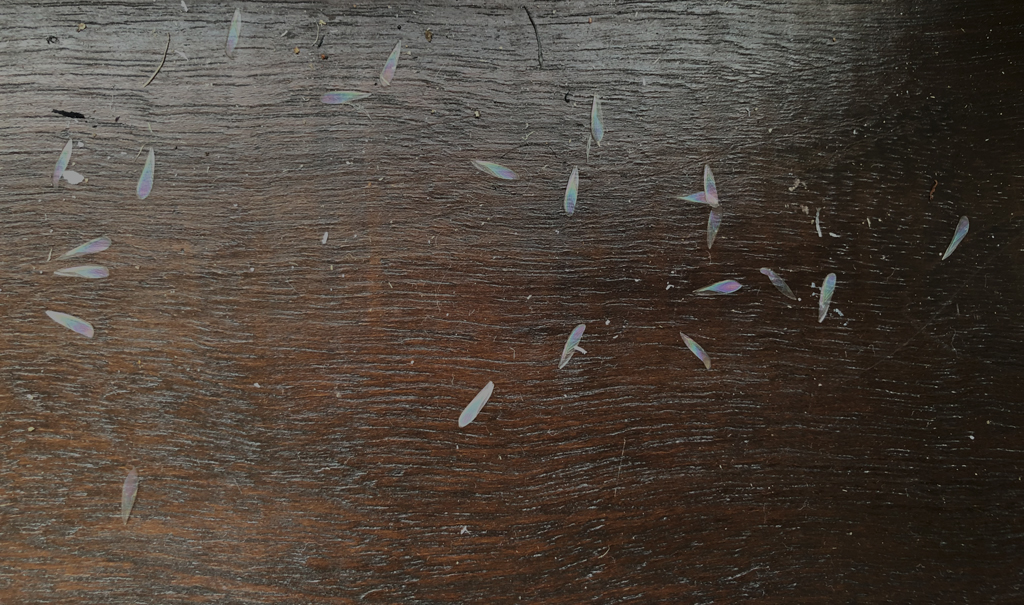
As I did a little research and observed the rainflies with a keener eye, more and more came to light about these familiar, yet unfamiliar insects. As usual, I learnt that Nature is once again full of surprises.
Here is what I discovered….
Firstly, rainflies are in fact not flies at all… they are either a termites or ants... Unnerving.
Fortunately, there’s no need to panic (not yet anyways).
As with bees, ants and termites form highly organised and intricate colonies, and are known as eusocial insects. These insect colonies are divided into "castes". Each caste has specific roles and contributes to the functioning and survival of the colony.
As it relates to the invasive "rainflies", they are actually belong to caste known as alates.
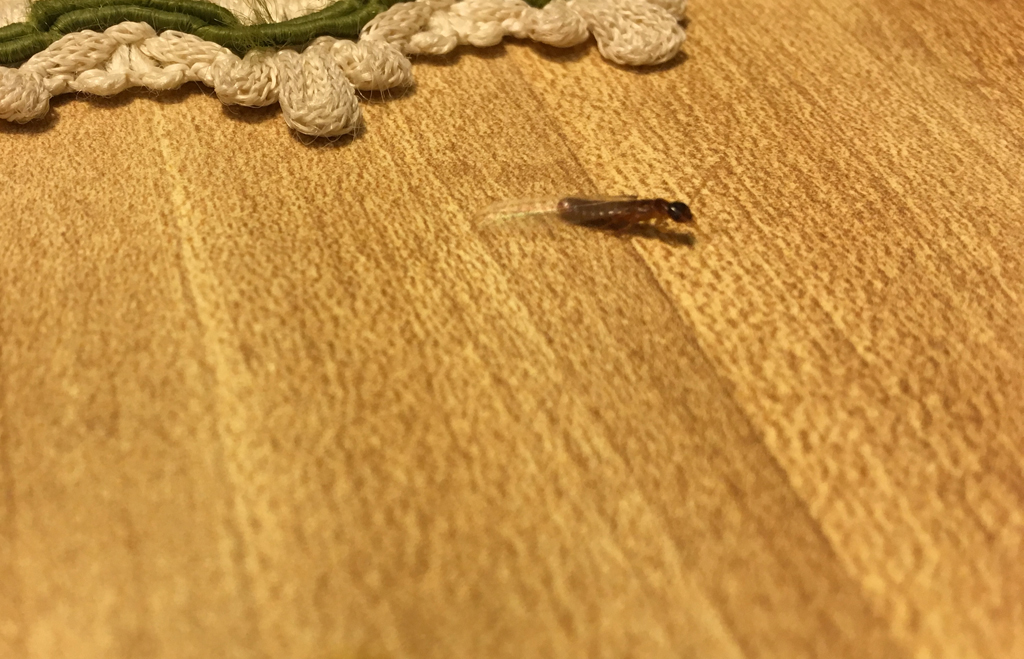
Alates is a term used to refer to the "winged" caste of colonies (mainly termites and many species of ants). Also known as "swarmers" or "reproductives", alates are the caste within their colonies which are fertile and have the specific function to reproduce. They subsequently develop new colonies, thereby continuing their species. Alates therefore, become the queens (as well as kings, in the case of termites) of the colony which they establish.
|
|
It is important to bear in mind that - termite and ant species are diverse and the behaviours and life-cycle patterns may vary from species to species.
For example, not all species of ants have alates in their colonies, have other ways by which they mate and/or reproduce.
Crawling out of the woodwork
In this post however, I will be looking at the mass invasion of the alates - known as "swarming".
Hundreds and perhaps thousands of male and female alates take what is known as a “nuptial flight” and swarm in order to mate with other alates from different colonies.
Swarming occurs when the colonies are "mature" (about 2-4 years). Furthermore, the atmospheric conditions need to be just right - temperature, wind and humidity levels are contributing factors which also effect the emergence of swarms and also explains why rainflies sometimes active after a rainfall and especially during rainy/hurricane season.
After finding a partner, the alates permanently discard their wings (dealation) and at this stage are known as “dealates”.
Research indicates if the swarmers are not able to mate quickly enough, they will die - which many of them do.
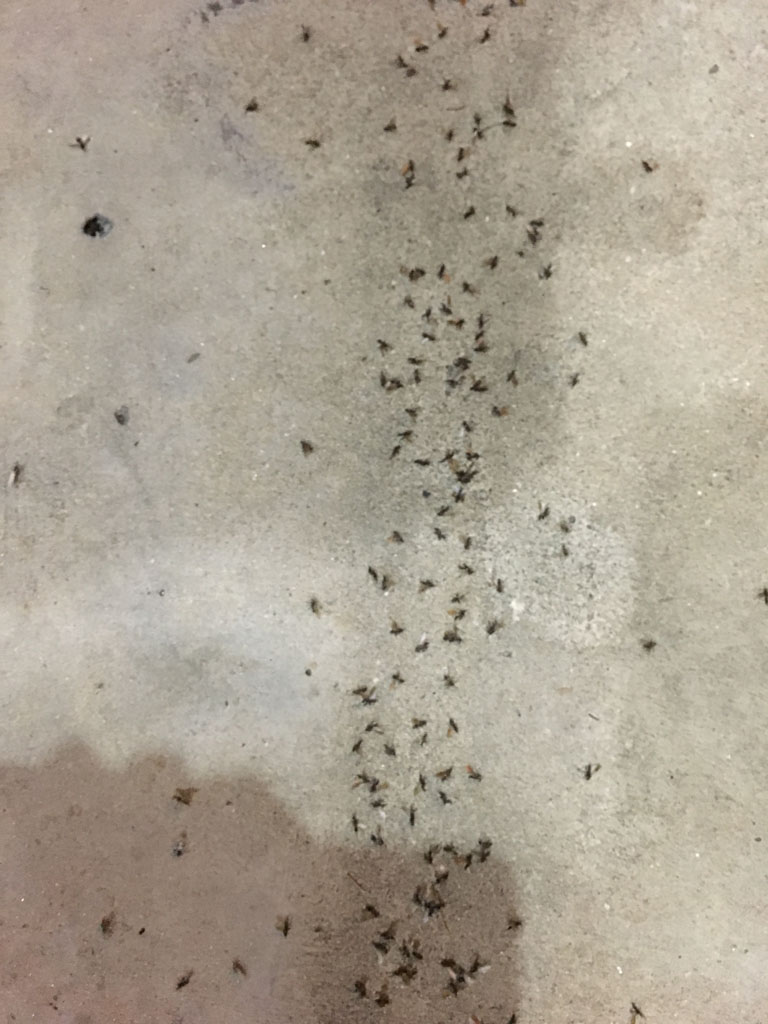
I thought a rainfly was just a rainfly
At first glance, termite and ant alates appear very similar. However, further research and closer examination reveals a difference in the physical structure of the swarmers.
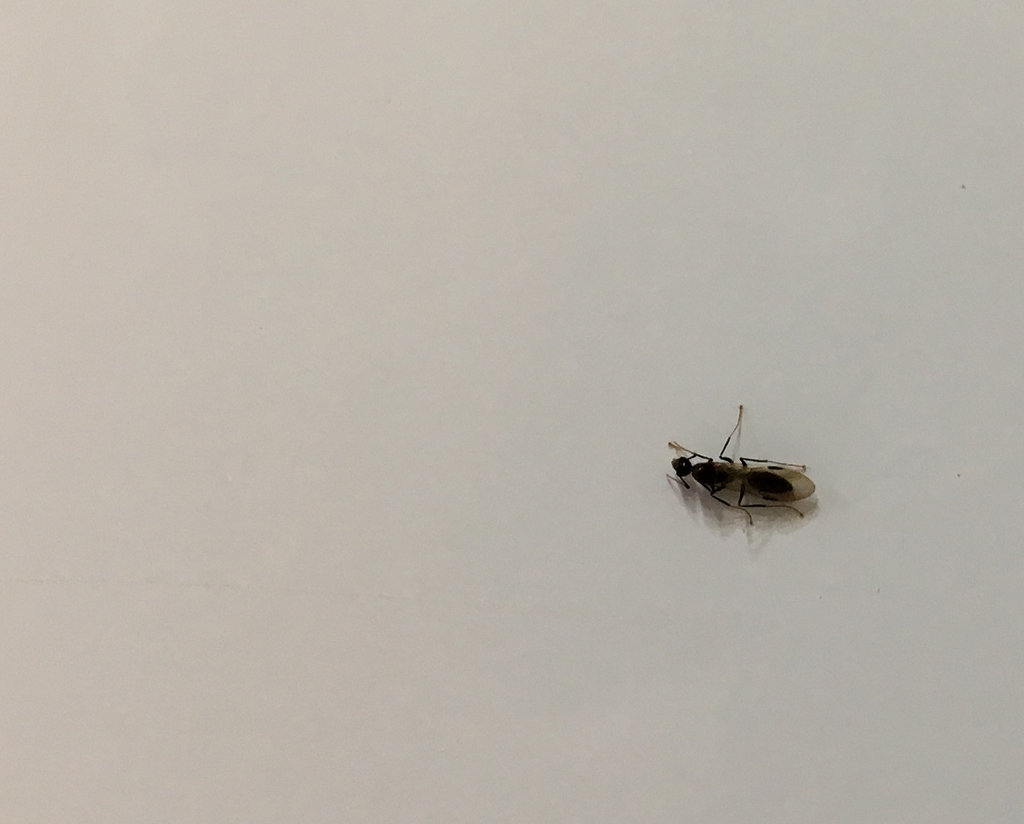
Termite alates have gently curved antennae, an elongated body and two pairs of long wings of equal length. Ant alates on the other hand have been described as
| |
having "bent" or "elbowed" antennae, a clearly segmented body and two sets of wings, with one set being smaller than the other.
A little more about alates
The main purpose of alates is to find a partner and mate to form a new colony and continue their species. Therefore, their swarms are not a direct infestation, or threat. The bad news however, is that it is said that alates do not swarm far away from their colonies - and I am guessing will establish colonies in close proximity to the area which they swarm.
Due to the sheer volume of insects, swarming alates are a nuisance outdoors as well as indoors. While researching alates, it was brought to my notice that the swarms also attracts the attention of predators, such as birds, bats, frogs and lizards. As I paid closer attention to the swarms, I also noticed the behaviour of their predators. Perched on wires and in trees, near street lights, king birds glide swiftly towards their prey. A quick "snap" is a telling sign that a the bird has caught an insect. Bats on the other hand, are not as graceful and with jagged movements, zig-zag through the air. Frogs, toads and lizards, keep extremely still, waiting for the right moment to make their move... and in the blink of an eye, an unsuspecting insect is gone.
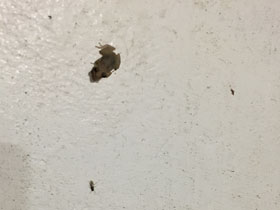
Reproductives are the only caste in their colonies which have the ability to fly and although some ant and termite species generally have poor vision (if any at all) the alates are drawn to light.
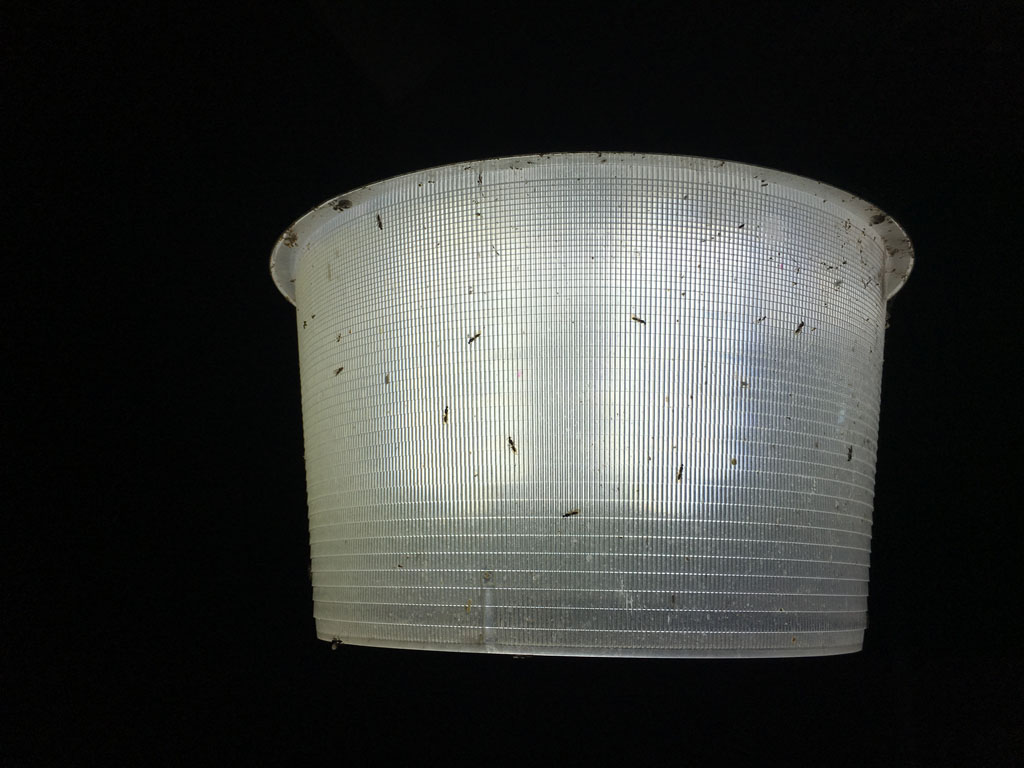
There are worse things…
Although I cannot say that I am thrilled about termites and ants swarming my house (and office), it was very interesting to discover what rainflies actually are and the importance they play to the survival and continuation of their species. As I continue to observe the swarms, I hope to learn more. |
|
|
|